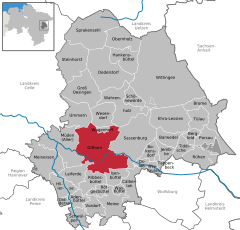This article includes a list of general references, but it lacks sufficient corresponding inline citations. (April 2009) |
Gifhorn | |
|---|---|
 Gifhorn Castle | |
Location of Gifhorn within Gifhorn district  | |
| Coordinates: 52°29′19″N 10°32′47″E / 52.48861°N 10.54639°E | |
| Country | Germany |
| State | Lower Saxony |
| District | Gifhorn |
| Subdivisions | 6 districts |
| Government | |
| • Mayor (2019–24) | Matthias Nerlich[1] (CDU) |
| Area | |
| • Total | 104.86 km2 (40.49 sq mi) |
| Highest elevation | 68 m (223 ft) |
| Lowest elevation | 50 m (160 ft) |
| Population (2022-12-31)[2] | |
| • Total | 43,625 |
| • Density | 420/km2 (1,100/sq mi) |
| Time zone | UTC+01:00 (CET) |
| • Summer (DST) | UTC+02:00 (CEST) |
| Postal codes | 38501–38510, 38516, 38518 |
| Dialling codes | 05371 |
| Vehicle registration | GF |
| Website | www.stadt-gifhorn.de |
Gifhorn (German pronunciation: [ˈɡɪfhɔʁn] ) is a town and capital of the district of Gifhorn in the east of Lower Saxony, Germany. It has a population of about 42,000 and is mainly influenced by the small distance to the more industrial and commercially important cities nearby, Brunswick and Wolfsburg. Further, Gifhorn is part of the Hanover-Brunswick-Göttingen-Wolfsburg Metropolitan Region. The Municipality Gifhorn includes the villages of Gamsen, Gifhorn, Kästorf, Neubokel, Wilsche and Winkel.
- ^ "Verzeichnis der direkt gewählten Bürgermeister/-innen und Landräte/Landrätinnen". Landesamt für Statistik Niedersachsen. April 2021.
- ^ "LSN-Online Regionaldatenbank, Tabelle A100001G: Fortschreibung des Bevölkerungsstandes, Stand 31. Dezember 2022" (in German). Landesamt für Statistik Niedersachsen.


